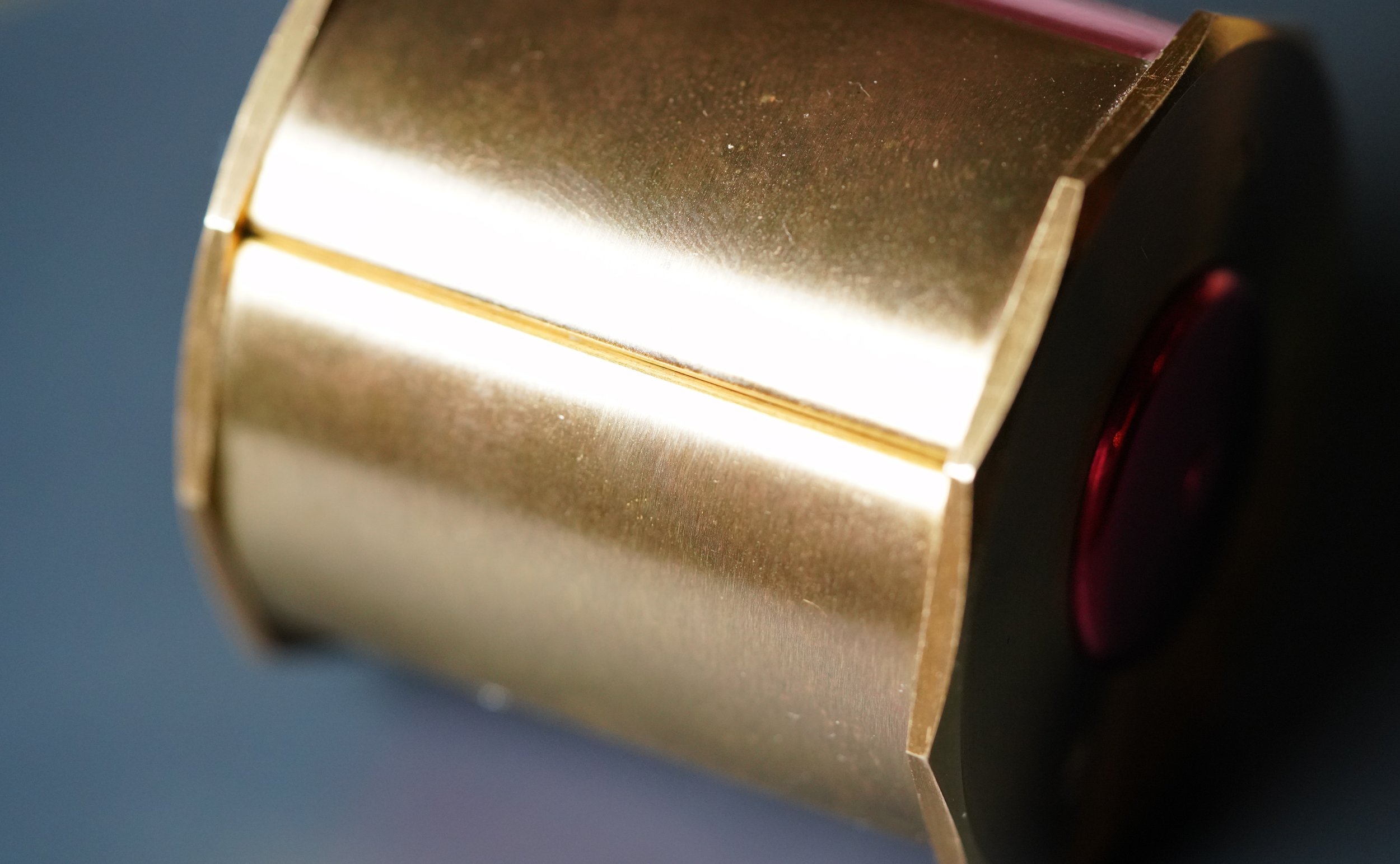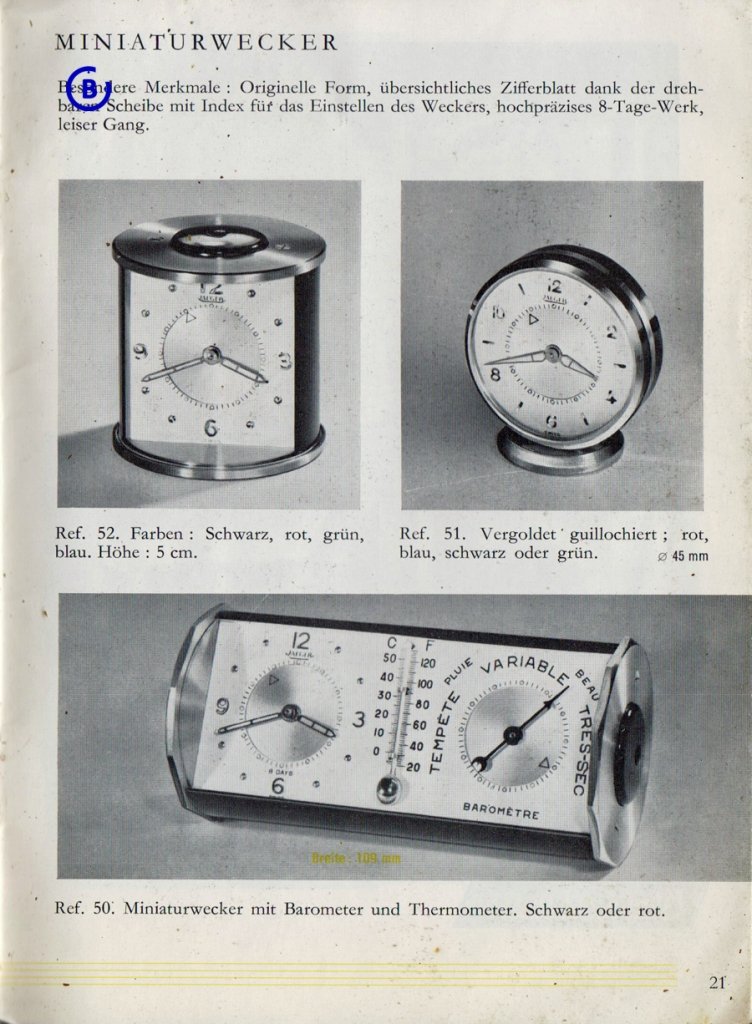‘Vintage LeCoultre 8 Day Alarm Travel Clock Reference 53’
The travel clock was almost a forgotten horological accessory until an iconic limited edition release in June of 2020. While it was initially met with some criticism, the HODINKEE Eight-Day Travel Clock served to highlight one of the beloved genres in watchmaking. After the year of lock-down, travel clocks (and stationary clocks) had become the quintessential timepiece to have in one’s collection. The growing surge of new watch enthusiasts would continue to raise prices on what were once affordable wristwatches. With this in mind, wristwatches from less-celebrated makers, pocket watches, clocks and other horological accessories would remain the final battle ground for those eagerly hunting for budget-friendly timepieces.
Among the many makers of travel clocks, one manufacturer has an unrivaled history. While Jaeger-LeCoultre is recognized for their eponymous Atmos clock, their line of portable desk timepieces remain greatly underappreciated.
“Within David Landes’ book ‘Revolution in Time’, the author explains that the evolution in timekeeping devices coincided with gradual change in the vernacular. While the sundials, clepsydras and other devices were referred to as “horologia”, the burgeoning bell towers across Europe would eventually make “clock” become an associated word amongst English, French, Dutch and German speakers. While most will understandably refer to stationary timepieces (whether on buildings, walls or desks) as “clocks”, it makes for an enjoyable side note to share amongst watch enthusiasts.” (1)
English: Clock. French: Cloche. Dutch: Clokke. German: Glocke
Representing the true definition of a “clock”, the alarm models from the Le Sentier brand are certainly worthy of higher accolades. Within the article, we will examine the Jaeger-LeCoultre 8 Day Alarm Travel Clock reference 53.
Cadeaux advertisement from the late 1930s featuring early Jaeger-LeCoultre 8 Day Clocks. Image credit: hifi-archiv.info
The decagonal profiles are slightly longer, giving it a height of 52mm. The side of the case is decorated with a concentric brush, while the slightly beveled edge is accentuated by a mirror finish.



Reference 53
Within the right interior section, the reference is indicated by the number 53 below “LeCoultre Co”. It is worth noting that this can be seen without disassembly. It simply requires the shutter-style caseback to be slid open. The circular section located on the perimeter allows the shutters to be slid open and shut.
Upon removal of the decagonal sides, there are no further indications to note. However, there are textured lanes that align to keep the dial in a fixed position.
The shutters can conceal or highlight the brass colored section of the travel clock. models will feature different colors. According to Blomman Watch Report, reference 51 comprises of “red, blue, black and green”. The circles located on the profile should in theory correspond with each other. One thing to note is that these brass sheets remain fixed to hold the plexiglass in place. The pins located at the end are impressed within the short holes on the interior lining of the decagonal profiles.
Shutter caseback opened.
Shutter caseback closed.
The Dial
The present example is an American market travel clock, noted by the dial featuring “LeCoultre”. There are also examples for the European market which feature “Jaeger” or “Jaeger-LeCoultre”. The rotating alarm disk features a concentric-bushed dial, with a non-luminous triangle which will indicate the designated time to be reminded.
The fixed or exterior dial features applied Arabic numerals for 3,6,9 and 12, accompanied by applied circular markers for the remaining hours. The inner section has luminous-hour markers, along with painted minute markers. The minute markers essentially reference every 12-minute increment, making for a slightly less accurate alarm setting. Wristwatch models such as the LBJ Cricket were designed with a slightly more user-friendly decimal track on the perimeter of the dial. The setting for the alarm from the interior dial will not typically be the most accurate.
The exterior dial features a slightly gradient texture, which is more discernible without the plexiglass.
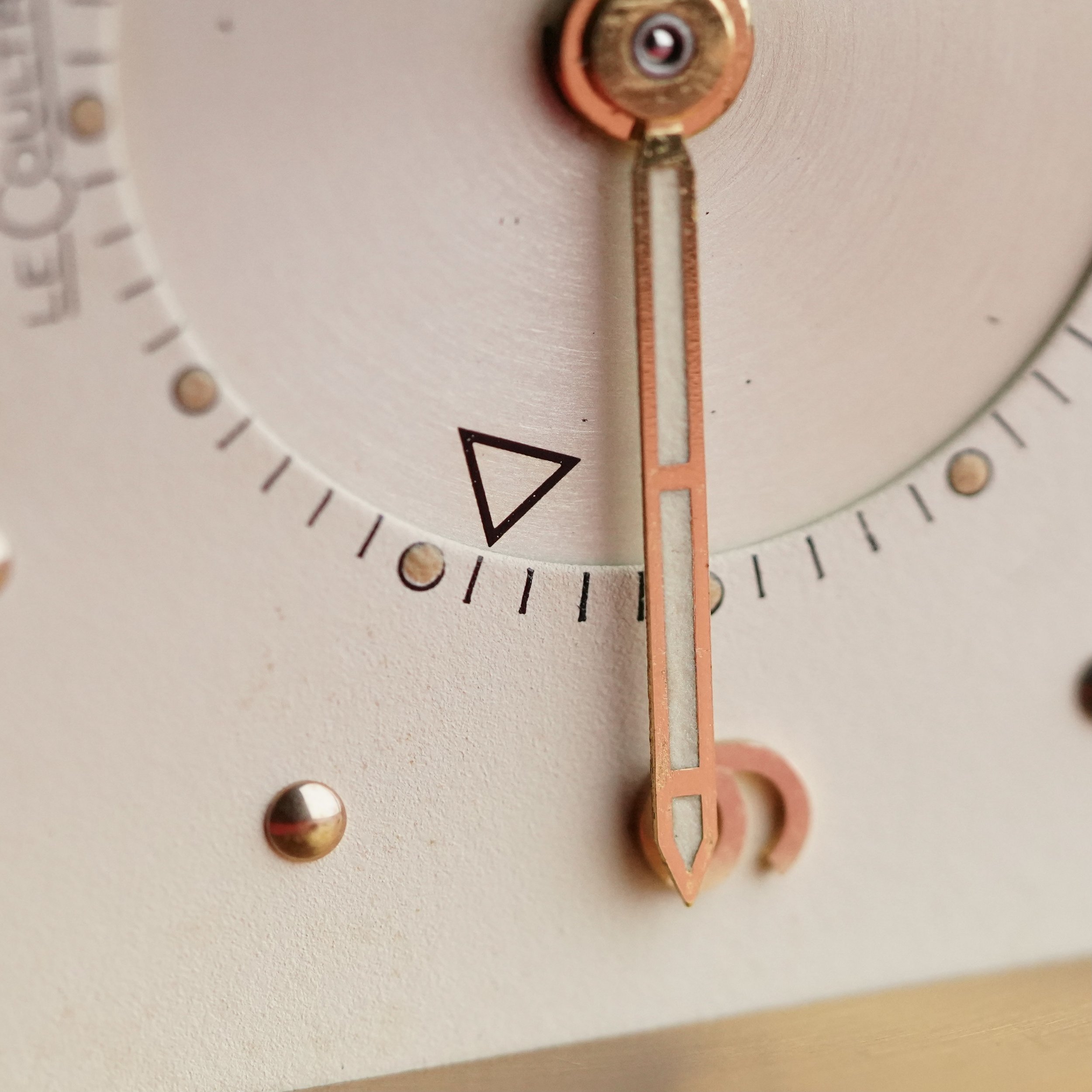

“8-DAYS” indication above the applied 6 numeral.

Movement
After unscrewing the clock’s caseback to learn that the process of inspecting the movement would require a higher level of comfort than I was prepared for, I decided to reassemble it. I’m fairly certain the timepiece is powered by the 19-ligne Calibre 219, The cal. 219 is is featured within several 8-day alarm clocks throughout the 1950s, yet the alarm clocks from the brand date back to the 1930s.
The movement’s technical sheet can be seen below, and seemingly indicates the same structured components on the exterior caseback.

Image credit: https://watchguy.co.uk/
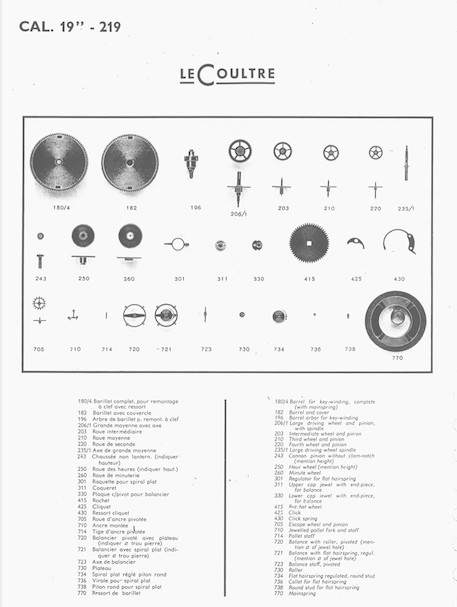
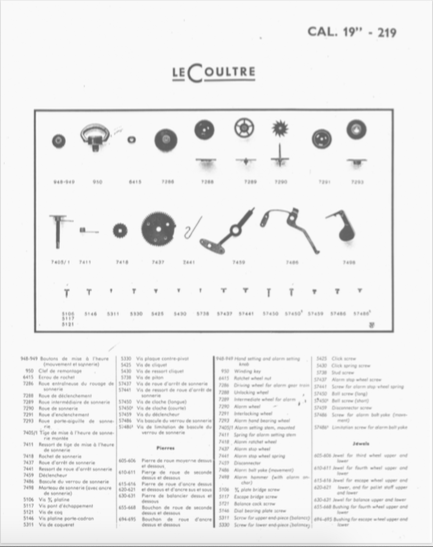
The Alarm
Both the time and alarm can be set by independent crowns. The movement and alarm are powered by the hinged stem. The alarm sounds for an 11 second increment, with an amplified volume from the brass case. While it is ringing, the alarm can be disengaged by pressing in the red circle on the left-facing side.
Advertisements
While the Atmos and Memovox models were the core models, they are more often spotlighted within JLC’s advertisements throughout the mid-century. Occasionally travel clocks, and other desk timepieces are depicted within the company’s marketing, and often highlighted within American newspaper advertisements. More often the vertically styled 8 Day Alarm Clock (reference 52) is seen within the ads. However, the LeCoultre reference 53 is also found within the manufacturer’s promotional material.
Image credit: Europa Star (ASIA | 1956 | Issue #38)
The advertisement’s caption for the reference 53 reads:
“For the desk. This finely styled calendar clock houses an excellent eight-day movement. The miniature alarm is only two inches in height, yet it has eight-day precision movement.”
Jaeger-LeCoulre advertisement from the 1950s featuring a European market reference 53. Image credit: Europa Star (ASIA | 1956 | Issue #38)
German Jaeger-LeCoultre catalogue excerpt from circa 1957 featuring a “vertical” Jaeger-LeCoultre 8 Day Alarm Travel Clock. Notice the similar elongated, horizontal layout in reference 50, which includes the barometer and thermometer. Image Credit: Blomman Watch Report.
Acknowledgements
A special thank you to the following parties for lending insight and resources: hifi-archiv.info, Blomman Watch Report, WatchGuy.co.uk, Wind Vintage and Europa Star.
To read about other Jaeger-LeCoultre timepieces, see below:
‘A Vintage Jaeger-LeCoultre Memovox Catalog Circa 1958’
‘Collector’s Guide: Jaeger-LeCoultre Memovox Reference E 875’
‘LeCoultre Chronograph Reference 224115’
‘Vintage LeCoultre Memovox Reference 2404 (Circa 1960s)’
‘Vintage Jaeger-LeCoultre Memovox Reference 3157 aka the “Travalarm”’
Jaeger-LeCoultre Reference 11012 Retailed by Hermès
Jaeger-LeCoultre Memovox Reference E 851
LeCoultre Memodate: A Vintage Gold-Filled Gift For A 13 Year Old Collector
Watches Within A 1938 Men's Fashion Catalog
Photo Gallery Vintage Jaeger-LeCoultre Reference 2957‘
Parechoc and the P450/4C’: What is Parechoc, and what is it doing in my JLC?














